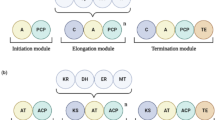Abstract
l-Lysine is known to stimulate production of β-lactam antibiotics byStreptomyces clavuligerus via provision of the lysine breakdown product,l-α-aminoadipic acid, which is a limiting precursor. Previous investigations utilized levels of 10–20 mMl-lysine as an addition to chemically-defined media resulting in 50–100% improvement in antibiotic production. We were surprised to note that as the concentration was further increased, the organism responded by producing even higher titers of antibiotics. The optimum concentration of 100 mMl-lysine yielded an approximate 500% increase in production with only minor effects on growth.dl- andd-lysine also exerted enhancements suggesting the presence of a lysine racemase or some other route fromd-lysine tol-α-aminoadipate in this organism;d-lysine was considerably less potent thandl- orl-lysine.
Similar content being viewed by others
References
Demain AL, Masurekar P (1974) Lysine inhibition of in vivo homocitrate synthesis inPenicillium chrysogenum. J Gen Microbiol 82:143–151
Friedrich CG, Demain AL (1977) Homocitrate synthase as the crucial site of the lysine effect on penicillin biosynthesis. J Antibiot (Tokyo) 30:760–761
Jensen SE, Demain AL (1994) Beta-lactams. In: Vining LC, Stuttard C (eds) Genetics and biochemistry of antibiotic production. Butterworth-Heinemann, Boston, pp 239–268
Kern BA, Hendlin D, Inamine E (1980)l-Lysine ɛ-aminotransferase involved in cephamycin C synthesis inStreptomyces lactamdurans. Antimicrob Agents Chemother 17:679–685
Kirkpatrick JR, Doolin LE, Godfrey OW (1973) Lysine biosynthesis inStreptomyces lipmanii: implication in antibiotic biosynthesis. Antimicrob Agents Chemother 4:542–550
Madduri K, Stuttard C, Vining LC (1989) Lysine catabolism inStreptomyces spp. is primarily through cadaverine; β-lactam producers also make α-aminoadipate. J Bacteriol 171:299–302
Madduri K, Stuttard C, Vining LC (1991) Cloning and location of a gene governing lysine ɛ-aminotransferase, an enzyme initiating β-lactam biosynthesis inStreptomyces spp. J Bacteriol 173: 985–988
Malmberg L-H, Hu W-S, Sherman DH (1993) Precursor flux control through targeted chromosomal insertion of the lysine ɛ-aminotransferase (lat) gene in cephamycin C biosynthesis. J Bacteriol 175:6916–6924
Mendelovitz S, Aharonowitz Y (1982) Regulation of cephamycin C synthesis, aspartokinase, dihydrodipicolinic acid synthetase, and homoserine dehydrogenase by aspartic acid family amino acids inStreptomyces clavuligerus. Antimicrob Agents Chemother 21:74–84
Trown PW, Smith B, Abraham EP (1963) Biosynthesis of cephalosporin C from amino acids. Biochem J 86:284–291
Whitney JG, Brannon DR, Mabe JA, Wicker KJ (1972) Incorporation of labelled precursors into A16886B, a novel β-lactam antibiotic produced byStreptomyces clavuligerus. Antimicrob Agents Chemother 1:247–251
Author information
Authors and Affiliations
Additional information
Participant in the MIT Undergraduate Research Opportunities Programs (UROP)
Rights and permissions
About this article
Cite this article
Fang, A., Keables, P. & Demain, A.L. Unexpected enhancement of β-lactam antibiotic formation inStreptomyces clavuligerus by very high concentrations of exogenous lysine. Appl Microbiol Biotechnol 44, 705–709 (1996). https://doi.org/10.1007/BF00178606
Received:
Revised:
Accepted:
Issue Date:
DOI: https://doi.org/10.1007/BF00178606




